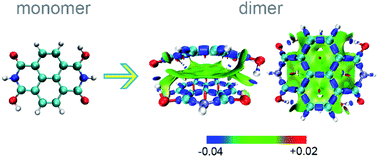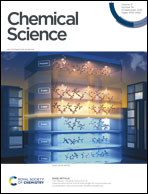Comprehending radicals, diradicals and their bondings in aggregates of imide-fused polycyclic aromatic hydrocarbons†
Abstract
Quantum effects such as ferromagnetism were regarded as rare in organic materials. When reduced to radical states, imide-fused polycyclic aromatic hydrocarbons (IPAHs) have shown room-temperature ferromagnetism in our recent work, to be a potential candidate as ferromagnetic semiconductor. Here, we use variational Davydov ansatz parametrized by density functional theory to investigate the structural and optical properties of IPAHs and their radicals at both molecule and aggregate levels. Our calculation reveals that hydrogen mainly gives rise to radicals and proves the formation of a mid-gap polaronic state, which is further evidenced by UV-vis absorption spectra simulations, in good agreement with experiments. The significant change of dispersion between the π–π stacking structure and planar structure implies the formation of radical–radical bonding (pancake bonding), which is revealed by simulations of NIR absorption signals and serves as the physical basis of long-range ferromagnetic orders. Absorption spectra of perylene diimide (PDI), terrylene diimide (TDI) and their radicals are also predicted.



 Please wait while we load your content...
Please wait while we load your content...